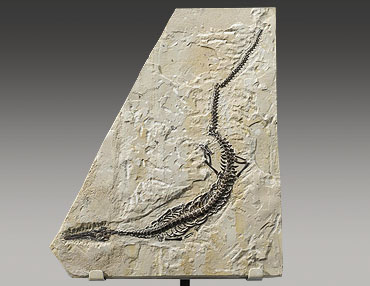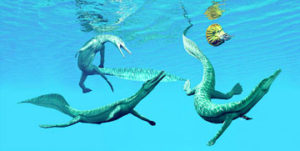
Mesosaurus tenuidens
Irati Formation, Brazil
300~280 MYA.
Mesosaurus was a prehistoric reptile about one meter in length that inhabited both the water and land. It lived during the Permian Period, which was 300-280 million years ago. As it spent most of its life in the sea, its main source of food was the shellfish that inhabited the area. Its physical structure made it unlikely to be a fast mover on land, so other sources of food were likely the carcasses of dead animals.
 Mesosaurus is most famous for its involvement in proving Continental Drift, or Plate Tectonics. Fossilized remains were unearthed along the western coast of South Africa. Identical fossils were discovered around the eastern coast of South America, in present day Uruguay and Brazil. As the distance between the two continents were too far for Mesosaurus to cross, a theory was postulated that the two continents were once joined together.
Mesosaurus is most famous for its involvement in proving Continental Drift, or Plate Tectonics. Fossilized remains were unearthed along the western coast of South Africa. Identical fossils were discovered around the eastern coast of South America, in present day Uruguay and Brazil. As the distance between the two continents were too far for Mesosaurus to cross, a theory was postulated that the two continents were once joined together.
Thus, Continental Drift or Plate Tectonics, the movement of continents due to undersea volcanic effects became the most logical conclusion. Though this theory had been initially proposed by Abraham Ortelius in 1596, it wasn’t fully embraced until the mid-1960s.
This specimen in light shale is virtually complete, with only minor dis-articulation, or missing structures. It was discovered in Brazil and acquired by the museum from a private party. It has since been sold at auction.